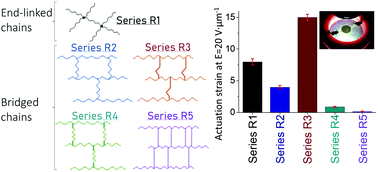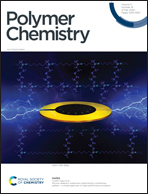Silicone dielectric elastomers optimized by crosslinking pattern – a simple approach to high-performance actuators†
Abstract
Silicone elastomers are one of the most promising materials for dielectric elastomer transducers (DETs). In the context of the intense research that is being done to improve the electromechanical performances, in terms of dielectric permittivity, Young's modulus and dielectric strength, through increasingly complex, sophisticated approaches, the simple way of optimizing the base polymer seems to have remained less explored. Depending on the real-world applications, these materials can easily be optimized in terms of mechanical and electromechanical properties by using appropriate molecular weight and crosslinking pattern. To demonstrate this, multiple series of silicone elastomer films differing by crosslinking pattern and molecular weight were prepared. Various crosslinking chemistries, more or less common for silicones, were addressed: condensation, dehydrocoupling, hydrosilylation and thiol–ene addition, leading to networks with end-crosslinked or bridged chains topologies, in the latter case the bridges having different lengths and flexibilities. The uniaxial and cyclic stress–strain tests showed a substantial change in the mechanical behaviour through variation of the two structural parameters mentioned. In addition, the crosslinking density determined by solvent swelling method correlate to the mechanical behaviour. Thus, the UV cured elastomeric networks, series R3, showed the lowest Young's modulus, ranging from 0.06 MPa to 0.32 MPa depending on the molecular weight of the involved polymer. By using same polymers as for series R3 but with a different crosslinking pattern based on hydrosilylation reaction of vinyl groups, series R5, the resulting elastomers exhibited a Young's modulus of about twenty times larger and an elongation at break below 50%. The data collected for the series of silicone films demonstrates the choice of optimum molecular weight and crosslinking pattern leads to elastomers without mechanical losses, dielectric strength over 100 V μm−1 or lateral strain of 15% at only 20 V μm−1. This twofold chemical optimization results in materials with targeted properties that can easily be adapted for real-life applications.



 Please wait while we load your content...
Please wait while we load your content...